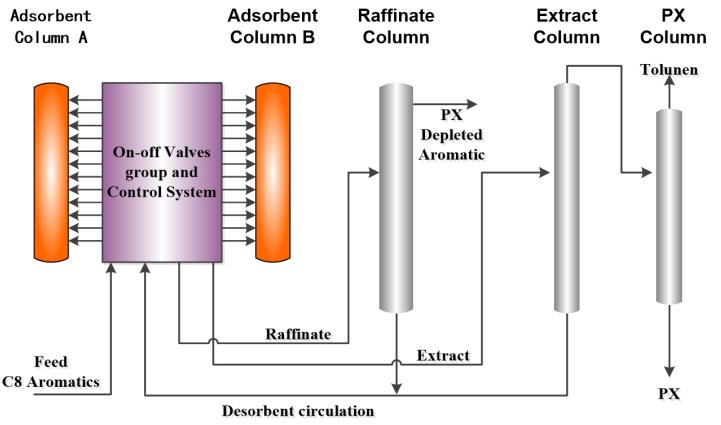I. Technology introduction
1. Technology application
As the para-xylene (PX) recovery unit of an integrated aromatic complex, simulating moving bed (SMB) adsorption process is utilized to obtain high purity PX product from the feed of a mixed C8 aromatic isomers, and the raffinate is sent to xylene isomerization unit to re-establish an equilibrium concentration of PX .
2. Process description
The PX separation process developed by Sinopec consists of the adsorption section and the subsequent distillation section. The adsorption columns are packed with PX adsorbent that is able to selectively separate PX from the mixed C8 aromatics. After further distillation, high-purity PX product can be obtained. The process flow diagram is shown in Figure 1.

Figure 1 Sinopec SMB adsorptive separation process
The adsorption section includes two adsorption columns, each have 12 adsorbent beds divided by internal grids. Each adsorbent bed has only one set of distribution/collection pipelines for stream injection/withdrawal. Two pumps provide liquid circulation from the bottom of one adsorption column to the top of another adsorption column respectively, to form a continuous loop of all adsorbent beds. The streams entering and leaving the beds include C8 aromatics feed, desorbent, extract, raffinate as well as flushing streams. Under a program control, sequencing on-off valves are used to periodically change injection/withdrawal positions of each stream to simulate a moving bed of adsorbent with countercurrent flow of the liquid against the solid adsorbent, to achieve continuous separation operation. The flushing streams consisting of the desorbent, extract and feed stream respectively, are used to flush the remaining material in the pipeline into the corresponding beds, and guarantee high PX purity, as well as enhance the efficiency of the adsorbent.
The mixed C8 aromatics feed is charged into the adsorption zone of adsorption columns, where PX is selectively adsorbed and separated by the adsorbent. The raffinate is sent to the raffinate column where the desorbent and C8 aromatics stream depleted in PX are separated by conventional distillation. The top cut of C8 aromatics is transported to xylene isomerization unit. Desorbent from the bottom of the column joins the stream from the bottom of the extract column and is recycled back into the desorption zone of adsorption columns.
PX on the adsorbent is recovered by the desorbent and transported to the extract column, then separated from desorbent by distillation. Overhead crude PX cut is transported to the finishing column. Bottom desorbent cut mixed with raffinate bottom stream is used as recycled desorbent.
The top crude toluene cut from finishing column is pumped to upstream disproportionation unit. Bottom PX with high purity is pumped to the product tank.
3. Main process conditions
Table 1 Main operation parameters
| Item | Reference value |
| Temperature/℃ | 150~180 |
| Bottom pressure/ MPa | 0.8~0.9 |
| Pressure drop/ MPa | ≯0.4 |
| Cad/F | 3.0~4.2 |
| Cycle time/ min | 20~50 |
| γ1 | 0.16~0.25 |
| γ2 | 0.07~0.13 |
| γ4 | -0.03~-0.07 |
II. Technical characteristics
1. Technical Flexibility
In addition to the production of high purity PX, this process can also be used for the production of high purity para-diethylbenzene (PDEB) from a mixture of diethyl benzene isomers.
2. Feed adaptability
This process can handle a variety of sources mixed C8 aromatic isomers, including from catalytic reforming, steam cracking, etc. However, the amount of polar contaminants in the feed, such as water, olefin, oxygen, sulfur and nitrogen containing compounds, etc., is strictly restricted.
3. Technical economy
The process operates under low desorbent circulation rate. The ratio of desorbent circulation rate to feed rate of the mixed C8 aromatics, i.e.,( D / F) is less than 1.0.
4. Product Quality
The main specifications of para-xylene obtained are shown in Table 2. The expected PX product purity is 99.8% with recovery rate of 98%.
Table 2 Main PX product specifications
| Item | specification |
| Purity/% (weight) | ≥99.7 |
| Non-aromatics/%(weight) | ≤0.10 |
| Toluene/%(weight) | ≤0.10 |
| Ethylbenzen/%(weight) | ≤0.20 |
| Metaxylene/%(weight) | ≤0.20 |
| Oraxylene/%(weight) | ≤0.10 |
| Total sulfur/(mg/kg) | ≤1.0 |
| Color(Pt-Co) | ≤10 |
| Acid-wash test | Acid layer color should be no deeper than that of the 0.10g/L potassium dichromate standard colorimetric solution |
| Br index/(mgBr/100g) | ≤200 |
5. Operation cycle
The expected adsorbent life is ≥ 8 years. It can be extended if the impurity content in the feed and desorbent is strictly controlled.
III. Adsorbent
RAX series PX adsorbents, including RAX-2000A, RAX-3000, RAX-4000 and RAX-4500, developed by Sinopec, have been commercially used since 2004. They enjoy high crush strength, low attrition rate, lower adsorbent bed pressure drop, and is favors for long-term operation. Their properties are shown in Table 3.
Table 3 Properties of RAX series adsorbents
| Item | RAX-3000 | RAX-4000/RAX-4500 |
| Active component | X zeolite | X zeolite |
| Appearance | sphere | sphere |
| Particle diameter/mm | 0.3~0.8 | 0.3~0.8 |
| Bulk density/(kg/m3) | 800~840 | 840~880 |
| Aromatics adsorption capacity/(mg/g) | ≥178 | ≥180 |
| Crushing rate (130N)/%* | ≤0.8 | ≤0.8 |
* Crushing rate refers to particle crush strength, the smaller the value, the higher the strength
IV. Application
A commercial demonstration unit using Sinopec PX adsorptive separation technology was built in 2011. In 2012, the PDEB product with over 99% purity was obtained by this unit. A 600KMTA and a 1000KMTA PX production units were built and started up at 2013 and 2019 respectively, the PX purity is more than 99.8% and the PX recovery rate more than 98%. A 1000KMTA PX production unit is under construction and will be started up in 2022. In addition, RAX series adsorbents have been applied in 7 refineries.

